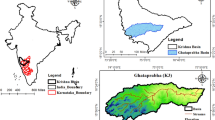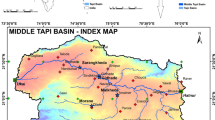Abstract
The availability of water in the Senegal River basin is a basic issue for moving towards efficient resource management. Given the extent of the river and the large number of stations, hydrological modelling is a reliable means of assessing the evolution of the water balance and availability over the last 30 years. This paper aims to evaluate water balance components and to model the water balance over the Senegal River basin from 1989 to 2020. The streamflow data have been calibrated and validated with the PEST program incorporated in WEAP with a NSE equal to 0.98, a PBIAS of 7% and a R2 of 0.98. The water balance has been computed using the Soil Moisture Method which use mainly climate data and runoff data to output different results driving to an analysis of the water balance components. The results have shown that the precipitation is the main alimentation of the river with a mean rainfall of 267,255.84 Mm3; the losses by evapotranspiration are 246,892.45 Mm3. According to the conventional formula, the water balance would be equal to 20,363.38Mm3 in the Senegal River basin. The modelling of the water balance in this basin will allow a further study concerning the effect of climate change on the hydrological and ecological system of the Senegal River basin. A variation in the resource and hydrological parameters was noted. Although the 30 years see a decrease in rainfall, runoff increases. However, it remains to integrate the water use parameters for better conclusions.

source: WEAP database







Similar content being viewed by others
References
Aggarwal SP, Thakur PK, Garg V, Nikam BR, Chouksey A, Dhote P, Bhattacharya T (2016) Water Resources Status and Availability Assessment in Current and Future Climate Change Scenarios for Beas River Basin of North Western Himalaya. ISPRS - International Archives of the Photogrammetry, Remote Sensing and Spatial Information Sciences XLI-B8(July), 1389–1396. https://doi.org/10.5194/isprs-archives-xli-b8-1389-2016
Anis MR, Andreichuk Y, Kerr SA, Sauchyn DJ (2021) Climate Change Risks to Water Security in Canada’s Western Interior (pp 25–60). https://doi.org/10.1007/978-981-16-0394-5_2
Ardoin S, Lubes-niel H, Servat E, Dezetter A, Boyer J, Mahe G, Paturel J-E (2003) Analyse de la persistance de la sécheresse en Afrique de l’ouest: caractérisation de la situation de la décennie 1990. Hydrology of the Mediterranean and Semiarid Regions (Proceedings of an International Symposium Held at Montpellier.’ April 2003). IAHS Publ. No. 278.2003, 278, 223–228
Bader J-C. (2014) Monographie hydrologique du fleuve Sénégal : de l’origines mesures jusqu’en 2011. In IRd Edition.
Bodian A, Dezetter A, Dacosta H (2016) Rainfall-runoff modelling of water resources in the upper Senegal River basin. Int J Water Resour Dev 32(1):89–101. https://doi.org/10.1080/07900627.2015.1026435
Bodian A, Dezetter A, Diop L, Deme A, Djaman K, Diop A (2018) Future climate change impacts on streamflows of Two Main West Africa River Basins: Senegal and Gambia. Hydrology, 5(1). https://doi.org/10.3390/hydrology5010021
Burgess JP, Owen T, Sinha UK (2016) Human securitization of water? A case study of the Indus Waters Basin. Camb Rev Int Aff 29(2):382–407. https://doi.org/10.1080/09557571.2013.799739
Cogels FX, Coly A, Niang A (1997) Impact of dam construction on the hydrological regime and quality of a Sahelian lake in the River Senegal basin. … Journal Devoted to River …. https://onlinelibrary.wiley.com/doi/abs/https://doi.org/10.1002/(SICI)1099-1646(199701)13:1%3C27::AID-RRR421%3E3.0.CO;2-G
Descroix L, Guichard F, Grippa M, Lambert LA, Panthou G, Mahé G, Gal L, Dardel C, Quantin G, Kergoat L, Bouaïta Y, Hiernaux P, Vischel T, Pellarin T, Faty B, Wilcox C, Abdou MM, Mamadou I, Vandervaere JP, … Paturel JE (2018) Evolution of surface hydrology in the Sahelo-Sudanian Strip: An updated review. Water (Switzerland), 10(6). https://doi.org/10.3390/w10060748
Droogers P, Allen RG (2002) Estimating reference evapotranspiration under inaccurate data conditions. Irrig Drain Syst 16(1):33–45. https://doi.org/10.1023/A:1015508322413
Etchells T, Malano H (2005) Identifying uncertainty in water allocation modelling. MODSIM05 - International Congress on Modelling and Simulation: Advances and Applications for Management and Decision Making, Proceedings, 2484–2490
Faty A (2017) Modélisation hydrologique du haut bassin versant du fleuve Sénégal dans un contexte de variabilité hydro-climatique : Apport de la télédétection et du modèle Mike SHE. Université Cheikh Anta Diop de Dakar
Faty A (2018) Impacts of climate demonstration on seasonal rainfall patterns in the upper watershed of Senegal. Int J Hydrol 2(6):718–724. https://doi.org/10.15406/ijh.2018.02.00149
Gorguner M, Kavvas ML, Ishida K (2019) Assessing the impacts of future climate change on the hydroclimatology of the Gediz Basin in Turkey by using dynamically downscaled CMIP5 projections. Sci Total Environ 648:481–499. https://doi.org/10.1016/j.scitotenv.2018.08.167
Kushwaha A, Jain MK (2013) Hydrological Simulation in a Forest Dominated Watershed in Himalayan Region using SWAT Model. Water Resour Manage 27(8):3005–3023. https://doi.org/10.1007/s11269-013-0329-9
Lubes-Niel H, Masson J, Paturel J-E, Servat E (1998) Variabilité climatique et statistiques. Etude par simulation de la puissance et de la robustesse de quelques tests utilisés pour vérifier l’homogénéité de chroniques. Journal of Water Science 11:383–408. https://doi.org/10.7202/705313AR
Mahe G, Olivry JC, Servat E (2005) Sensibilité des cours d’eau ouest-africains aux changements climatiques et environnementaux: Extrêmes et paradoxes. IAHS AISH Publ 296:169–177
Mahe G, Servat E (2004) Synthèse et évaluation des prévisions saisonnières en Afrique de l ’ Ouest. April
Mhiribidi D, Nobert J, Gumindoga W, Rwasoka DT (2018) Optimal water resource allocation modelling in the Lowveld of Zimbabwe. Proc Int Assoc Hydrol Sci 378:67–72. https://doi.org/10.5194/piahs-378-67-2018
Nayak PC, Wardlaw R, Kharya AK (2015) Water balance approach to study the effect of climate change on groundwater storage for Sirhind command area in India. Int J River Basin Manag 13(2):243–261. https://doi.org/10.1080/15715124.2015.1012206
Oseke FI (2020) Predicting the impact of water diversion and climate change on ecosystem functioning and hydrology within the Gurara reservoir catchment of Nigeria. Kwame Nkrumah University of Science and Technology
Oti JO, Kabo-bah AT, Ofosu E (2020) Hydrologic response to climate change in the Densu River Basin in Ghana. Heliyon 6(8):e04722. https://doi.org/10.1016/j.heliyon.2020.e04722
Paturel JE, Barrau C, Mahé G, Dezetter A, Servat E (2007) Modelling the impact of climatic variability on water resources in West and Central Africa from a non-calibrated hydrological model. Hydrol Sci J 52(1):38–48. https://doi.org/10.1623/hysj.52.1.38
Phue HT, Chuenchooklin S (2020) Existing water balance in the Bago River Basin, Myanmar. In: IOP Conference Series: Earth and Environmental Science, 552(1). https://doi.org/10.1088/1755-1315/552/1/012003
Quenum GMLD, Klutse NAB, Dieng D, Laux P, Arnault J, Kodja JD, Oguntunde PG (2019) Identification of potential drought areas in west africa under climate change and variability. Earth Syst Environ 3(3):429–444. https://doi.org/10.1007/s41748-019-00133-w
Rodier JA (1976) Evaluation De L’Ecoulement Annuel Dans Les Regions Tropicales Seches D’Afrique Occidentale. Cah ORSTOM Ser Hydrol 13(4):269–306
Saha AK, Setegn SG (2015) Ecohydrology: Understanding and Maintaining Ecosystem Services for IWRM. In: Sustainability of Integrated Water Resources Management (pp. 121–145). Springer International Publishing. https://doi.org/10.1007/978-3-319-12194-9_8
Sakho I, Dupont JP, Cisse MT, Janyani SE, Loum S (2017) Hydrological responses to rainfall variability and dam construction: a case study of the upper Senegal River basin. Environ Earth Sci 76(6):1–19. https://doi.org/10.1007/s12665-017-6570-4
Saleh A, Arnold JG, P. W. Gassman, L. M. Hauck, W. D. Rosenthal, J. R. Williams, & A. M. S. McFarland. (2000). Application of SWAT for the Upper North Bosque River Watershed. Transactions of the ASAE, 43(5), 1077–1087. https://doi.org/10.13031/2013.3000
Servat E, Paturel J, Kouame B, Travaglio M, Ouedraogo M, Boyer OIS, Marieu B (1998) d ’ une variabilite hydrologique en Afrique de l ’ ouest et centrale. Sierra, 252
Silva FB, Pereira SB, Vieira EDO, Pereira DR, Passos JBMC (2017). Sensitivity Analysis of the Water Balance Components of the WEAP Model for the High Rio Verde Grande Basin/mg. https://doi.org/10.7127/IV-INOVAGRI-MEETING-2017-RES5330946
Tena TM, Mwaanga P, Nguvulu A (2019) Hydrological modelling and water resources assessment of Chongwe River Catchment using WEAP model. Water (Switzerland), 11(4). https://doi.org/10.3390/w11040839
Wilcox C, Vischel T, Panthou G, Bodian A, Blanchet J, Descroix L, Quantin G, Cassé C, Tanimoun B, Koné S (2017) Trends in hydrological extremes in the Senegal and Niger Rivers. J Hydrol 566:531–545. https://doi.org/10.1016/J.JHYDROL.2018.07.063
Yaykiran S, Cuceloglu G, Ekdal A (2019) Estimation of water budget components of the Sakarya River basin by using the WEAP-PGM model. Water (Switzerland), 11(2). https://doi.org/10.3390/w11020271
Author information
Authors and Affiliations
Corresponding author
Additional information
Publisher's Note
Springer Nature remains neutral with regard to jurisdictional claims in published maps and institutional affiliations.
Rights and permissions
About this article
Cite this article
Thiam, M., Adjei, K.A., Niang, A. et al. Modelling the recent variations of water balance components and water availability within the Senegal River basin: using WEAP21 model. Model. Earth Syst. Environ. 8, 4517–4528 (2022). https://doi.org/10.1007/s40808-022-01420-8
Received:
Accepted:
Published:
Issue Date:
DOI: https://doi.org/10.1007/s40808-022-01420-8




